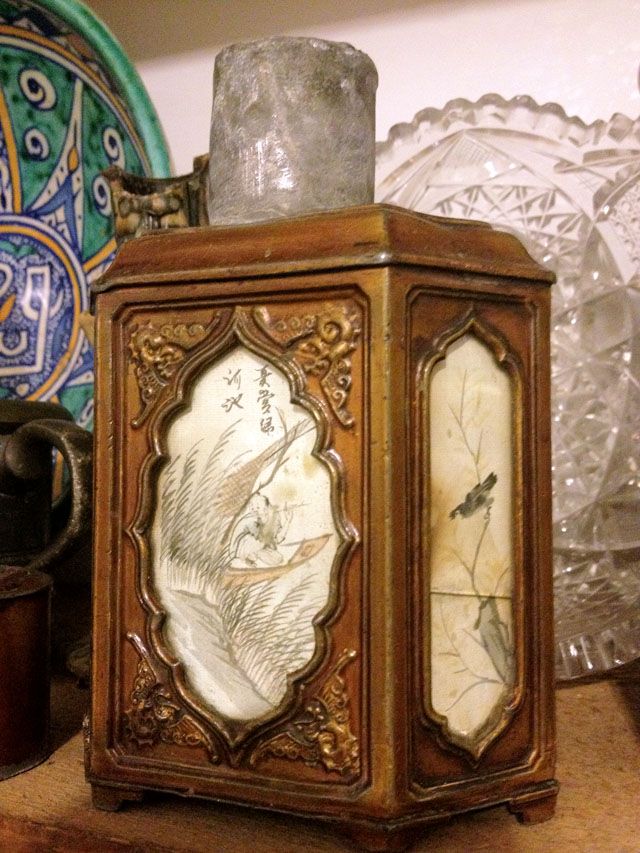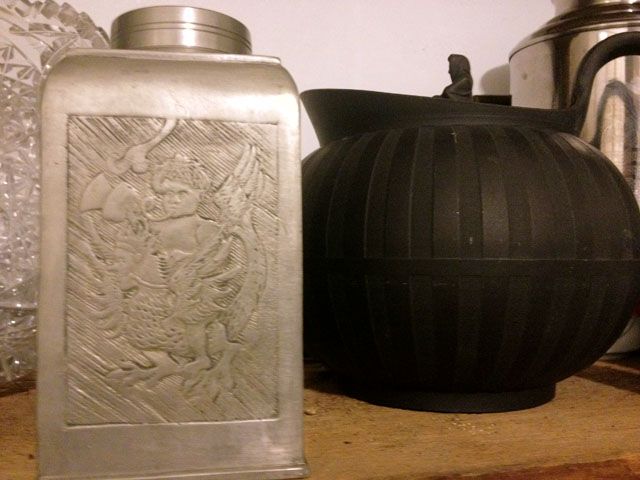Recently i have been finding a few old Chinese pewter tea caddies in the street markets here, dirt cheap - two, sized for maybe 200 g tea, i bought just yesterday for about 10 US$ a piece.
I guess they are from the early to mid 1900s. My question here for, i guess mostly for the antiques specialists, is about lead content of Chinese made pewter of that time.
If lead free i would love to use them to store tea. If not, i am happy enough just to have them as decoration, as they are really beautiful.
One i bought a while ago, even has a large old red paper label stuck to it (i guess that this would be anyhow not usable as it has a thick layer of white rust covering the inside, and i have no idea how to get rid of that).
Any ideas?
Oct 21st, '12, 13:00
Posts: 760
Joined: Aug 1st, '12, 08:20
Location: not anymore Bangkok, not really arrived in Germany
Re: Old pewter tea caddy question
Is it one of those darker pewter items? Or is it really shiny like stainless steel?
Oct 21st, '12, 22:32
Posts: 760
Joined: Aug 1st, '12, 08:20
Location: not anymore Bangkok, not really arrived in Germany
Re: Old pewter tea caddy question
Very dark patina.MarshalN wrote:Is it one of those darker pewter items? Or is it really shiny like stainless steel?
Oct 21st, '12, 22:47
Posts: 760
Joined: Aug 1st, '12, 08:20
Location: not anymore Bangkok, not really arrived in Germany
Re: Old pewter tea caddy question
The two caddies i bought over the weekend have been converted by the previous owner(s) to store lime paste used in chewing betel, took lots of boiling water to get the remains out. Seems that converting tea caddies for this use has been quite common here.
Re: Old pewter tea caddy question
If it's one of those darker ones, sounds like it's heavy in lead. Stuff that is basically just tin tend to look shiny and silvery metallic.
Oct 22nd, '12, 06:10
Posts: 760
Joined: Aug 1st, '12, 08:20
Location: not anymore Bangkok, not really arrived in Germany
Re: Old pewter tea caddy question
MarshalN wrote:If it's one of those darker ones, sounds like it's heavy in lead. Stuff that is basically just tin tend to look shiny and silvery metallic.
I fear that you are right.
Thanks a lot.
I will nevertheless continue buying when i see them offered on the flea markets, but just use them as decoration, and continue to use the cheap stainless containers.
Re: Old pewter tea caddy question
Why don't you post some photos?theredbaron wrote:MarshalN wrote:If it's one of those darker ones, sounds like it's heavy in lead. Stuff that is basically just tin tend to look shiny and silvery metallic.
I fear that you are right.
Thanks a lot.
I will nevertheless continue buying when i see them offered on the flea markets, but just use them as decoration, and continue to use the cheap stainless containers.
Re: Old pewter tea caddy question
Yes, some photos would help. But don't neglect looking inside and comparing the brightness/silvery look of the pewter to the outside.
Some pewter caddies, especially japanese ones are often decorated with motifs using corrosive liquids to create nice and delicate patterns. Those treatments give a less bright, more smoky finish to the tin/pewter.
This is often seen on chataku (cha tuo in chinese) and on tea caddies/plates of rather good quality (examples : http://www.artisticnippon.com/product/t ... addy5.html, http://www.ebay.com/itm/SHIP-FREE-JAPAN ... 1e73a1b15c, http://www.ebay.com/itm/230866568267?ss ... 1438.l2649, http://www.ebay.com/itm/230866568267?ss ... 438.l2649)
And one interesting (as usual) post from MarshalN on those tea caddies : http://www.marshaln.com/2008/03/saturday-march-29-2008/
Fabien
Some pewter caddies, especially japanese ones are often decorated with motifs using corrosive liquids to create nice and delicate patterns. Those treatments give a less bright, more smoky finish to the tin/pewter.
This is often seen on chataku (cha tuo in chinese) and on tea caddies/plates of rather good quality (examples : http://www.artisticnippon.com/product/t ... addy5.html, http://www.ebay.com/itm/SHIP-FREE-JAPAN ... 1e73a1b15c, http://www.ebay.com/itm/230866568267?ss ... 1438.l2649, http://www.ebay.com/itm/230866568267?ss ... 438.l2649)
And one interesting (as usual) post from MarshalN on those tea caddies : http://www.marshaln.com/2008/03/saturday-march-29-2008/
Fabien
Re: Old pewter tea caddy question
Ack, I just discovered a typo in that post!
I should really do another caddy post. It's been some years.
I should really do another caddy post. It's been some years.
Oct 23rd, '12, 10:16
Posts: 760
Joined: Aug 1st, '12, 08:20
Location: not anymore Bangkok, not really arrived in Germany
Re: Old pewter tea caddy question
Fabien wrote:Yes, some photos would help. But don't neglect looking inside and comparing the brightness/silvery look of the pewter to the outside.
Some pewter caddies, especially japanese ones are often decorated with motifs using corrosive liquids to create nice and delicate patterns. Those treatments give a less bright, more smoky finish to the tin/pewter.
I'll try to get over my bout of extreme laziness, and post some images soon. I hope.
The color of the patina is similar to the middle one and the second from the right in MarshalN's blog. They definitely do not look like the newer Japanese caddies from the links you have shown.
Re: Old pewter tea caddy question
Yes, they are definitely different from the Japanese ones. Even older Japanese ones used to contain high amounts of lead I've read, and they turn that heavy smoky color you mention.theredbaron wrote:Fabien wrote:Yes, some photos would help. But don't neglect looking inside and comparing the brightness/silvery look of the pewter to the outside.
Some pewter caddies, especially japanese ones are often decorated with motifs using corrosive liquids to create nice and delicate patterns. Those treatments give a less bright, more smoky finish to the tin/pewter.
I'll try to get over my bout of extreme laziness, and post some images soon. I hope.
The color of the patina is similar to the middle one and the second from the right in MarshalN's blog. They definitely do not look like the newer Japanese caddies from the links you have shown.
Some years ago, one of the tea shop owners in Hong Kong who carried his family's line of pewter caddies showed me the line. He said they were going out of business as demand has lessened and the costs to make them have risen. The quality of the ones he showed me were exceptionally well made. He told me that both the inner lid and the top were meant to slowly slide into place by themselves, displacing some of the air inside the caddy. He demonstrated this to me and the fit was really precision made. Something to look for in a good pewter caddy.
Re: Old pewter tea caddy question
Somebody posted a video of an Japanese artisan crafting a sakura bark tea caddy, and the lid showed the same quality (slowly sliding into place by itself) -- must be a common desired trait for properly made caddies, regardless of material?Tead Off wrote:The quality of the ones he showed me were exceptionally well made. He told me that both the inner lid and the top were meant to slowly slide into place by themselves, displacing some of the air inside the caddy. He demonstrated this to me and the fit was really precision made. Something to look for in a good pewter caddy.
Re: Old pewter tea caddy question
Here are two tea caddies. The first is antique, and the pewter is powdery and very flexible, it must have a seriously high lead content. I would not use it for tea, and I washed my hands after taking the cap off to show the top part, which is similar to the insides, uncoated.

The second is precision made, the top screws on and is more like stainless steel in terms fit. I think it is dutch, mid 20th c.
While the outside has a dull color from age and handling, the inside is still bright. I think this is food quality.

Honestly, pewter is not my first choice in a tea caddy. For pure function, stainless steel with the two top system is decent inexpensive storage, or for more astectic storage, I like the double lid ginger jars.

The second is precision made, the top screws on and is more like stainless steel in terms fit. I think it is dutch, mid 20th c.
While the outside has a dull color from age and handling, the inside is still bright. I think this is food quality.

Honestly, pewter is not my first choice in a tea caddy. For pure function, stainless steel with the two top system is decent inexpensive storage, or for more astectic storage, I like the double lid ginger jars.
Re: Old pewter tea caddy question
This would be very difficult to accomplish with ceramic which is my preferred material for Caddys. Aesthetically, the variation is endless and there is something about the contact of the leaves with clay.Drax wrote:Somebody posted a video of an Japanese artisan crafting a sakura bark tea caddy, and the lid showed the same quality (slowly sliding into place by itself) -- must be a common desired trait for properly made caddies, regardless of material?Tead Off wrote:The quality of the ones he showed me were exceptionally well made. He told me that both the inner lid and the top were meant to slowly slide into place by themselves, displacing some of the air inside the caddy. He demonstrated this to me and the fit was really precision made. Something to look for in a good pewter caddy.
Re: Old pewter tea caddy question
I think that pewter (esp. the good old stuff with some lead content, despite the potential safety concerns) insulates a bit better than stainless steel. And aesthetically, I think it beats out most of the stainless cans out there.TomVerlain wrote: Honestly, pewter is not my first choice in a tea caddy. For pure function, stainless steel with the two top system is decent inexpensive storage, or for more astectic storage, I like the double lid ginger jars.
That said, I do often use ceramic or stainless tea jars, for convenience, light weight, etc, and for storing large amounts of tea, often storage bags.
Some metal cans (whether pewter or stainless) seem to impart a bit more of a 'metallic' taste than others. I'll usually shake some of the tea I'm going to use in a jar around, and maybe leave it in there for a little while.